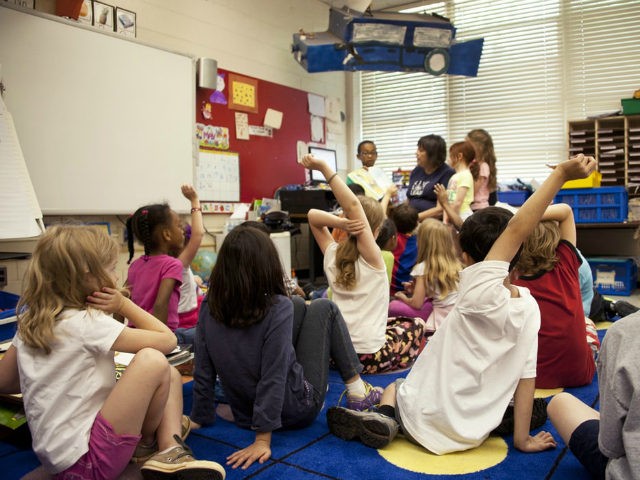The director of the Centers for Disease Control and Prevention (CDC) tweeted Friday that it is “critically important for public health to open schools this fall.”
It is critically important for our public health to open schools this fall. CDC resources will help parents, teachers and administrators make practical, safety-focused decisions as this school year begins. https://t.co/QSCGa85yT2 pic.twitter.com/hyajzvIgET
— Dr. Robert R. Redfield (@CDCDirector) July 24, 2020
Dr. Robert R. Redfield also posted a warning to parents that “school closures have disrupted normal ways of life for you and your children and they have had negative health consequences on our youth”:
Parents: School closures have disrupted normal ways of life for you and your children and they have had negative health consequences on our youth. See CDC resources on safely reopening schools: https://t.co/rKLn9kLKZt pic.twitter.com/1WrmIT3nQ8
— Dr. Robert R. Redfield (@CDCDirector) July 24, 2020
In an updated advisory Thursday, the CDC emphasized the importance of children returning to school this fall for their educational and social development.
At the same time, the U.S. health agency stressed to concerned parents that “the best available evidence indicates that COVID-19 poses relatively low risks to school-aged children.”
The CDC stated:
Children appear to be at lower risk for contracting COVID-19 compared to adults. To put this in perspective, according to the Centers for Disease Control and Prevention (CDC), as of July 17, 2020, the United States reported that children and adolescents under 18 years old account for under 7 percent of COVID-19 cases and less than 0.1 percent of COVID-19-related deaths. Although relatively rare, flu-related deaths in children occur every year. From 2004-2005 to 2018-2019, flu-related deaths in children reported to CDC during regular flu seasons ranged from 37 to 187 deaths. During the H1N1pandemic (April 15, 2009 to October 2, 2010), 358 pediatric deaths were reported to CDC. So far in this pandemic, deaths of children are less than in each of the last five flu seasons, with only 64.
The CDC also stated that studies suggest “COVID-19 transmission among children in schools may be low.”
“Based on current data, the rate of infection among younger school children, and from students to teachers, has been low, especially if proper precautions are followed,” the CDC continued. “There have also been few reports of children being the primary source of COVID-19 transmission among family members.”
The agency observed that extended school closures are harmful to many children who may suffer “severe learning loss” without in-person instruction:
Disparities in educational outcomes caused by school closures are a particular concern for low-income and minority students and students with disabilities. Many low-income families do not have the capacity to facilitate distance learning (e.g. limited or no computer access, limited or no internet access), and may have to rely on school-based services that support their child’s academic success.
The CDC observed that in-person instruction in schools also “provides children with access to a variety of mental health and social services, including speech language therapy, and physical or occupational therapy to help the physical, psychological, and academic well-being of the child.”
On Wednesday, Redfield told ABC’s Good Morning America that he would “absolutely” send his grandchildren back to school in the fall despite concerns about the coronavirus:
.@ABC NEWS EXCLUSIVE: @CDCDirector Dr. Robert Redfield on how bad the COVID-19 crisis could get. “It is very hard to predict.”https://t.co/aQQ6s3kY6z pic.twitter.com/PbiMPVNNHQ
— Good Morning America (@GMA) July 22, 2020
“It’s not public health versus opening the school versus reopening schools and the economy,” he said. “It’s public health versus public health.”
The CDC continued in its latest advisory:
Schools are an important part of the infrastructure of our communities, as they provide safe, supportive learning environments for students, employ teachers and other staff, and enable parents, guardians, and caregivers to work. Schools also provide critical services that help meet the needs of children and families, especially those who are disadvantaged, through supporting the development of social and emotional skills, creating a safe environment for learning, identifying and addressing neglect and abuse, fulfilling nutritional needs, and facilitating physical activity. School closure disrupts the delivery of in-person instruction and critical services to children and families, which has negative individual and societal ramifications.
The CDC recommends schools model and encourage preventive behaviors, including social distancing, wearing of face coverings, handwashing hygiene, and frequent disinfection of surfaces:
Together, we can open schools safely. This fall, school may look different in some communities b/c of #COVID19 – as face masks, distancing, & hand hygiene meet bookbags & homework. New CDC tools will help us make decisions for the upcoming school year. https://t.co/efgarAsMeq pic.twitter.com/jf284y1XGZ
— Dr. Robert R. Redfield (@CDCDirector) July 23, 2020
“The best available evidence from countries that have opened schools indicates that COVID-19 poses low risks to school-aged children, at least in areas with low community transmission, and suggests that children are unlikely to be major drivers of the spread of the virus,” the health agency stated.
According to a recent report at Science, more than 20 countries affected by the coronavirus pandemic sent their children back to school by early June.
Countries such as Taiwan, Nicaragua, and Sweden never even closed their schools, the report noted.
The CDC advisory comes one week after presumptive Democrat 2020 nominee Joe Biden warned Americans that it is “just plain dangerous” for children to return to school this fall, despite statements by many physicians to the contrary.

COMMENTS
Please let us know if you're having issues with commenting.